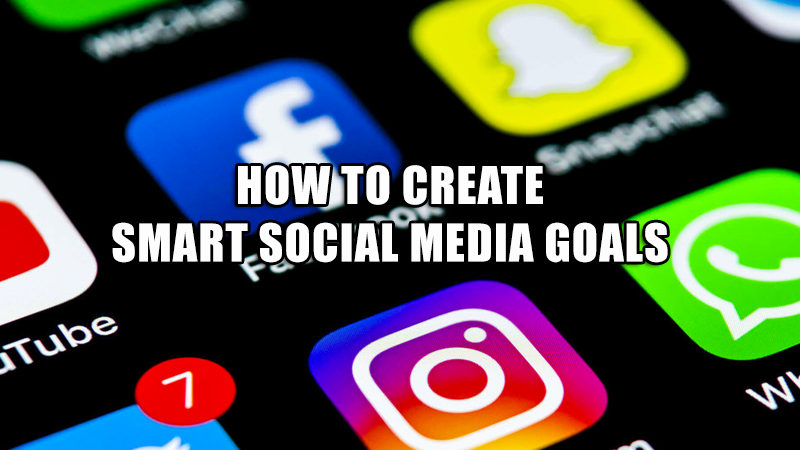
Ever wonder why social media works so well for some — but seems like a waste of time for others?
The secret to being successful on social media is having a social media strategy with clear goals and understanding how you will use your channels to reach them.
Seems easy enough, right? Where most people go wrong in setting goals is that they pull an aspirational outcome out of thin air and “work hard” until they achieve it. But how do you know you’re doing the actions that will get you there?
When you choose the wrong goals, you waste time, money, and keep your attention away from something that might work better. If you’re the type of person that likes crushing goals with a clear idea of how to make them happen, then you’re going love this goal-setting system.
I’m going to walk you through the top 3 social media goals and teach you exactly how to create “SMART” goals.
Let’s dive in!
Why You Need Social Media Goals
If you’re spending time planning, creating, and promoting content, wouldn’t you want to make sure you’re getting the best results possible?
To maximize your social media efforts, your posts need to fit into a larger picture. Then you can create content that serves those goals, instead of just giving your audience something to engage with.
Some businesses have a lot of goals, while others only have a one or two. Without them, it’s hard to learn from what you’re doing and even harder to figure out what tactics are getting the best results for your brand.
The clearer your goals are, the easier it will be for you to brainstorm content ideas and come up with ways to reach more people and earn new followers.
Top 3 Social Media Goals (and Metrics to Help You Track Them)
Social media is a key channel for brand awareness, engagement, customer service and much more. The key to any goal is to ensure it’s reachable, and that means you need to know what social media metrics help you track them.
Below is a list of 3 different goals you can target when you create your SMART goals at the bottom of this blog post.
Brand Awareness
This is the most popular social media goal by far, with more than 75% of companies listing this as a top priority for their business.
Just because many marketers have the same goal, doesn’t mean it’s measured the same for each brand. Some may be trying to build brand recognition, while others could be established players trying to reach new types of customers. If you don’t measure brand awareness in a way that makes sense for your goals, you’ll struggle to see the results you want.
Potential metrics for measuring thought leadership
- Number of Followers: “How many people are interested in my brand?”
- Post Reach/Impressions: “How many people is my brand reaching?”
- Page views/Profile Clicks: “How many people are visiting my profile?”
- Shares/Retweets: “How many people are sharing my content?
- Mentions: “How many people are talking about my brand?
- Video views: “How many people are watching my content?
How to track social media thought leadership
- Native analytics: most social media platforms provide tools to track your page’s performance. If you need help figuring out how to access this, try clicking these links for guidance: Facebook, Twitter, LinkedIn, Instagram, YouTube, Pinterest.
- Third-party tools: using social media management tools like HootSuite, Buffer, Sprout Social, or Sprinklr, you can make tracking and reporting as sophisticated as you like. You can also track the growth and reach of various channels all in one place.
Thought Leadership
Becoming a thought leader is all about positioning yourself and your brand as industry experts. If you do it successfully, you’ll become the go-to resource for your audience they’re looking for answers, ideas, or in-depth opinions.
A key part of becoming a thought leader is making sure you’re consistently sharing your opinions or guidance with your community. For this reason, it’s a good idea to schedule it into your editorial calendar. There are seven metric-based ways to measure your rise as a thought leader.
Potential metrics for measuring brand awareness
- Number of Posts: “How many times have I shared my expertise?”
- Shares/Retweets: “How many times has my expertise been shared?”
- Replies/Comments: “How many conversations have I started?”
- Quotes/Tags/Mentions: “How many people are talking about me?”
- Number of Recommendations: “How many times am I being endorsed?”
- Influencer mentions: “How many influencers are talking about my content?”
- Outreach: “How many people are asking me industry questions?”
How to track social media thought leadership
- Native analytics: Similar to the last section, one way to track this is with the analytics section of different social platforms.
- Third-party tools: Similar to the last section, you can use social media management tools to track various social media metrics.
- Influencer mentions: People won’t always tag you on a post, so using tools like Mention, Tweet Deck, and Google Alert will let you know if someone mentions you on social media, in the news, or on their blogs.
Customer Satisfaction
Social media has transformed customer service. Although at first glance the idea of customers broadcasting their complaints and problems about your brand sounds like a PR nightmare, it allows you to showcase how you treat customers, listen to their concerns, and address their problems. If you do it well, this pubic customer service can actually help you increase revenue, satisfaction, and retention.
But how do you measure something like satisfaction? The best way is to focus on the effectiveness of your customer service efforts.
Potential metrics for measuring brand awareness
- Reviews/Ratings: “How are customers rating me?”
- Response Time: “How long am I taking to respond to customers?”
- Testimonials/Mentions: “How are customers talking about me?”
- Engagement Time: “How long is it taking me to solve problems?”
- Number of Proactive Responses: “How am I staying ahead of complaints?”
How to track social media thought leadership
- Native analytics: For low volumes, you can manually track these right from your company channels.
- Third-party tools: If you have a high volume of customer support inquiries, then you could use a social media customer service tool like Buffer Reply to access relevant data.
How to Make Your Goals SMART
One of the most effective goal-setting techniques is called SMART. It’s a simple aconym brands can use to add clarity and focus to their social media efforts.
Here’s how it works:
- S – Specific: The more specific you can be with writing down your objective, the easier it will be to clearly see what it is you need to accomplish. Often, answering the five “W” questions—Who, What, Where, Why, and Which—can help you achieve greater specificity.
- M – Measurable: Can your goal be measured? How will you know when you’ve achieved your goal?
- A – Attainable: Another way of putting this is “realistic.” Is it possible to achieve the goal you’ve set for yourself?
- R – Relevant: For businesses, a relevant goal means that it has the potential to impact your business objectives, vision, or values.
- T – Time-bound: Give your goal a deadline.
When you apply this to your strategy, start with the goals you’re trying to achieve over the year. Then align these goals with what you’re trying to get out of your efforts on social media.
Some brands set different goals for each social media channel, while others have the same goals across each channel. I recommend you choose 2-3 goals and consider which platform is best for achieving them.
Here’s an example for brand awareness on Twitter:
- Specific: I want to grow my Twitter followers because Twitter is a key social media platform that I use to learn about customers and important industry trends”
- Measurable: Choose a specific number for the growth
- Attainable: Make sure the number is realistic
- Relevant: Does growing your Twitter following support your business’s objectives, vision, or values?
- Time-bound: What deadline will you set?
“I wish to grow my Twitter following from 15,000 followers to 38,000 followers by May 31, 2020.”
Over to Your Social Media Goals
Always try to make sure every part of your social media strategy is tied to your goals. What kind of goals are you trying to accomplish on social media?
If you need help coming up with ideas for goals and metrics, check our Free 32 Social Media Goals & Metrics Cheat Sheet.
I’d love to hear from you about how you tied SMART goals into your overall social media strategy to grow your brand. If you want to learn the step-by-step process we use to create strategies for industry-leading clients, sign up for our upcoming Easy Social Strategy course.








 Bacon Sports is a sports content & social media marketing agency that turns your audience into raving fans by creating fun and engaging videos, podcasts, and social media content.
Bacon Sports is a sports content & social media marketing agency that turns your audience into raving fans by creating fun and engaging videos, podcasts, and social media content.
